During January to March 2022, the total volume of palay production in the MIMAROPA Region was estimated at 271,980 metric tons. Among provinces in the region, Palawan’s palay production of 108,794 metric tons got the highest share of about 40.0 percent in the regional production of palay. This was followed by the production in Oriental Mindoro at 88,416 metric tons (32.5 percent share) and Occidental Mindoro at 50,524 metric tons (18.6 percent share). Meanwhile, the combined palay production from Romblon and Marinduque of 24,246 metric tons was accounted to 8.9 percent share in the MIMAROPA’s total palay production.
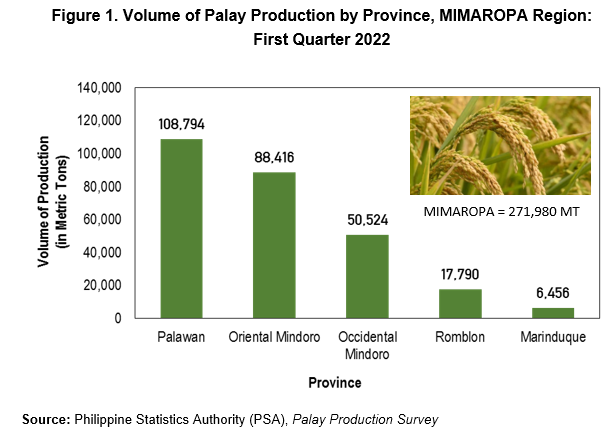
Palay produced in the MIMAROPA Region were predominantly grown and harvested from irrigated ecosystem at 201,003 metric tons. This accounts to 73.9 percent of the total volume of palay production in the region. Among provinces, the largest share of palay production from irrigated ecosystem was in Occidental Mindoro at 100.0 percent. Other provinces in the region whose palay production were predominantly grown and harvested from irrigated ecosystem during first quarter of 2022 were Oriental Mindoro (83.3 percent), Palawan (59.0 percent), Marinduque (55.5 percent), and Romblon (51.4 percent).
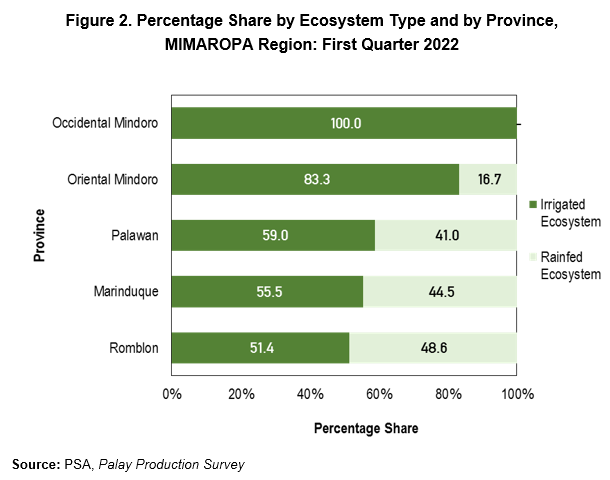
Volume of palay production down by 1.6 percent
MIMAROPA Region’s palay production of 271,980 metric tons during January to March 2022 was lower by 4,025 metric tons or 2.0 percent with respect to 276,280 metric tons of palay produced last first quarter of 2021. Among provinces, Palawan posted the largest decline of 7,304 metric tons or 6.3 percent cut back from the same quarter in the previous year. Marinduque and Occidental Mindoro followed with a corresponding decrement of 1,575 metric tons (19.6 percent), and 421 metric tons (0.8 percent) relative to their respective production relative to the same quarter of the previous year.
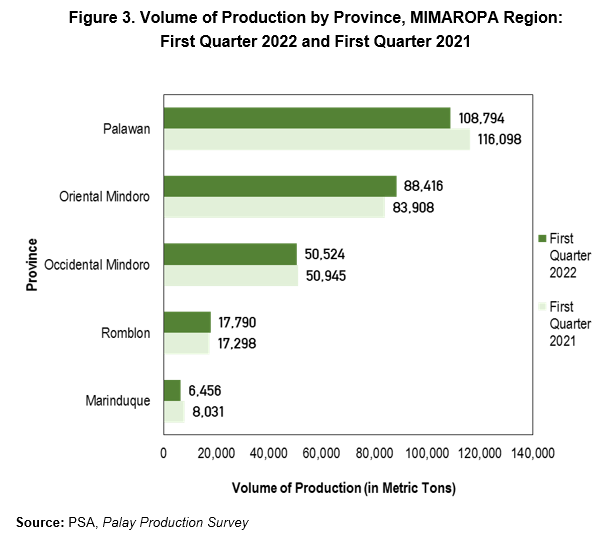
Palay grown and harvested from irrigated ecosystem during January to March 2022 exhibited a decline by 2.0 percent at 201,003 metric tons from 205,025 metric tons from the same quarter of the previous year. The decrease was contributed by the cut back in the production of palay from irrigated farms in Palawan (5,122 metric tons), Marinduque (819 metric tons), and Occidental Mindoro (421 metric tons).
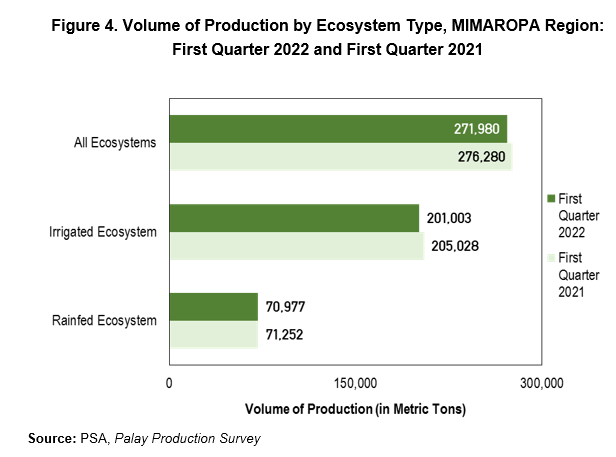
Likewise, palay production from rainfed ecosystem in the first quarter of 2022 at 70,977 metric tons slightly went down by 275 metric tons from the region’s total production of 71,252 metric tons during the same quarter of the previous year. This was contributed by the decline in palay production from rainfed ecosystem in Palawan (2,182 metric tons) and Marinduque (756 metric tons).
Total palay area harvested shrank by 1.5 percent
Total area harvested for all palay ecosystems during January to March 2022 in the MIMAROPA Region reached 68,341 hectares. Among provinces, Palawan recorded the largest area harvested at 28,007 hectares. Oriental Mindoro and Occidental Mindoro followed with corresponding reported area harvested of 22,254 hectares and 11,197 hectares. Meanwhile, the area harvested from Romblon and Marinduque lagged behind at 4,871 hectares and 2,012 hectares, respectively.
The regional total area harvested exhibited a decrease by 1.5 percent or 1,003 hectares compared to the recorded harvested area of 69,344 hectares last first quarter of 2021. Palawan led in the decline of the region’s area of land on which palay were grown and harvested with 1,720 hectares cut back. Marinduque followed with a reported decrease of 674 hectares.
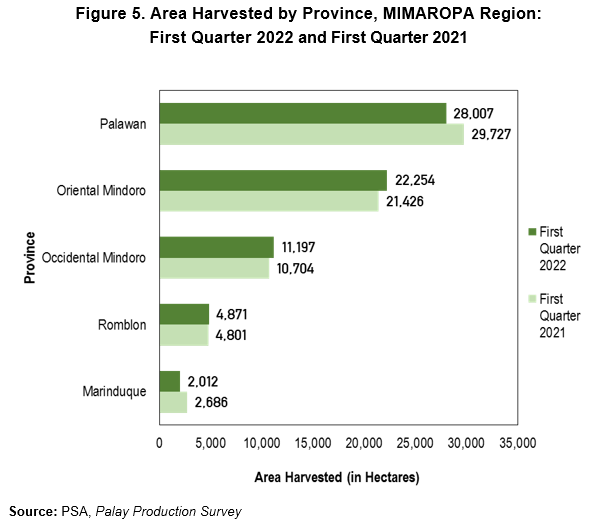
During January to March 2022, a decrease in the area harvested of the region was noted on both irrigated and rainfed ecosystems. Area harvested on rainfed ecosystem went down by 783 hectares or 3.7 percent from 21,108 hectares last first quarter of 2021 to 20,325 hectares in the same quarter of 2022. The shrinkage of area harvested was contributed by Palawan (667 hectares) and Marinduque (446 hectares).
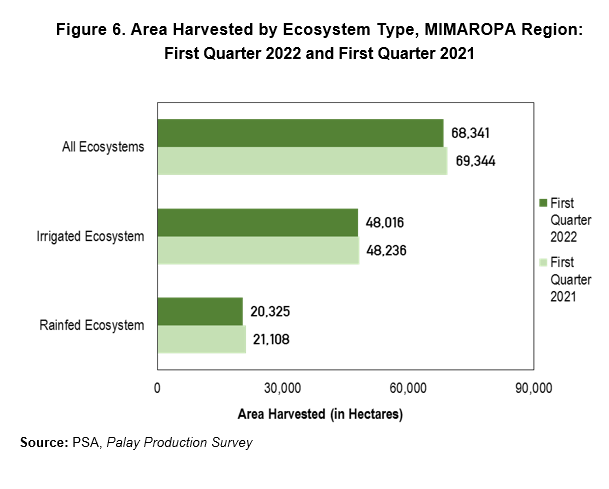
Likewise, the area harvested for irrigated ecosystem slightly decreased by
220 hectares or 0.5 percent from 48,236 hectares last first quarter of 2021 down to 48,016 hectares during first quarter of 2022. Palawan (1,053 hectares) and Marinduque (228 hectares) accounted for the decrease in the area harvested.
Average palay yield registered at 3.98 metric tons per hectare
The annual average palay yield of the MIMAROPA Region during January to March 2022 was registered at 3.98 metric tons per hectare. Among provinces in the region, only Occidental Mindoro exceeded the regional average yield at 4.51 metric tons per hectare. Meanwhile Marinduque’s annual average yield of 3.21 metric tons per hectare posted the lowest average yield.
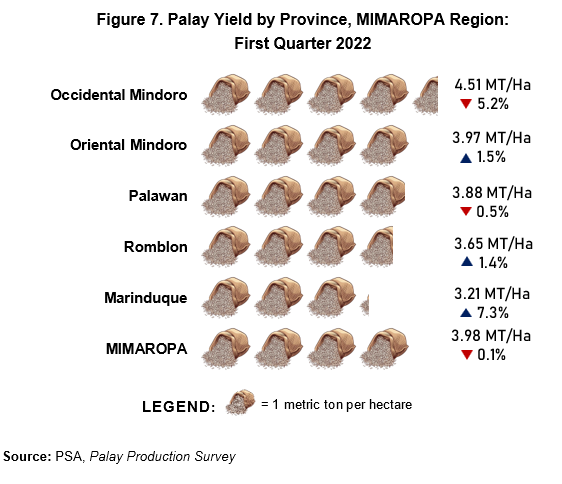
With respect to the average palay yield during January to March 2022, the regional average yield slightly decreased by 0.1 percent. This was contributed by the experienced decline in the average yield in Occidental Mindoro (5.2 percent) and Palawan (0.5 percent). On the other hand, the province of Marinduque posted a significant increase in the yield by 7.3 percent, while the yield of Oriental Mindoro and Romblon slightly went up by 1.5 percent and 1.4 percent, respectively.

TECHNICAL NOTES
Palay Production Survey (PPS) is a major quarterly agricultural survey conducted by the Philippine Statistics Authority. Its main objective is to generate estimates on palay production, area and yield, and other production-related data. Production data from this survey serves as direct inputs in the value of production in the Philippine Agriculture and Fisheries, and to the computation of the Gross Domestic Product. In addition, this survey also supports the data needs of planners, policy and decision makers on palay, and stakeholders in the agricultural sector, particularly the National Economic and Development Authority (NEDA), Department of Agriculture (DA) and its attached agencies such as Philippine Rice Research Institute (PhilRice), Philippine Council for Agriculture and Fisheries (PCAF), and the general public.
Data gathered in PPS are as follows: (1) production, area planted/harvested and yield by ecosystem and by seed type; (2) usage of seeds, fertilizer and pesticides;
(3) source of irrigation water and adequacy, monthly distribution of production and area harvested; (4) farm household disposition of production; and (5) area with standing crop, farmer’s planting intention for the quarter.
Definition of Terms
Palay production refers to the quantity of palay produced and actually harvested during the reference period. It includes those harvested but damaged, stolen, given away, consumed, given as harvesters’ and thresher’s shares, reserved, etc. Palay production from seed growers which are intended for seed purposes is excluded from the survey.
Two ecosystem types are considered in palay production. These are as follows:
1. Irrigated ecosystem refers to area with irrigation facilities supplying water through gravity, force/power, pump, and other artificial means.
2. Palay grown on a rainfed ecosystem has dikes that retain water and solely dependent upon rainfall for its water supply.
Area harvested refers to the actual area from which harvests are realized. This excludes crop areas which were totally damaged. For palay, the harvest area refers to the effective area harvested during the reference quarter.
Yield is an indicator of production derived by dividing the total production by the area harvested.

